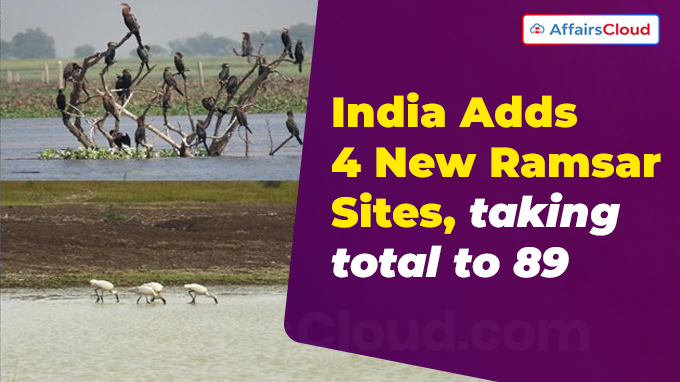 On 31 January, 2025, Union Minister Bhupender Yadav, Ministry of Environment, Forest and Climate Change (MoEF&CC) announced the inclusion of four new wetlands from India in Ramsar Convention list, bringing the total number of internationally recognized Ramsar sites in India to 89.
On 31 January, 2025, Union Minister Bhupender Yadav, Ministry of Environment, Forest and Climate Change (MoEF&CC) announced the inclusion of four new wetlands from India in Ramsar Convention list, bringing the total number of internationally recognized Ramsar sites in India to 89.
- The newly added sites are the Sakkarakottai Bird Sanctuary and Therthangal Bird Sanctuary in Tamil Nadu (TN), Khecheopalri Wetland in Sikkim, and Udhwa Lake in Jharkhand. This also marks the first Ramsar sites for both Sikkim and Jharkhand.
- Tamil Nadu now has 20 Ramsar sites, the highest number in India, followed by Uttar Pradesh (UP) with 10.
Note: Globally, there are 2,529 Ramsar wetlands. Wetlands are unique ecosystems that play a crucial role in supporting diverse species of plants and wildlife, both aquatic and terrestrial.
Newly added 4 Ramsar Sites of India:
| Name of Wetland | Location | Area (in hectares) |
|---|---|---|
| Khecheopalri Wetland | West Sikkim District, Sikkim | 11.56 |
| Udhwa Lake | Sahebganj District, Jharkhand | 565 |
| Therthangal Bird Sanctuary | Ramanathapuram District, Tamil Nadu | 29.5 |
| Sakkarakottai Bird Sanctuary | Ramanathapuram District, Tamil Nadu | 230.49 |
| Total Area of the four Wetlands | 836.55 | |
Khecheopalri Wetland:
The Khecheopalri Wetland, located in the Demazong valley, West Sikkim District of Sikkim, covers an area of 11.56 ha.
i.This unique wetland is a glacier-formed Cirque lake, situated at an elevation of 1,700 meters (m).
ii.It serves as an important habitat for various Trans-Himalayan migratory birds, including species like the Great Barbet and Long-tailed Shrike.
Udhwa Lake:
Udhwa Lake, located in the Sahebganj District of Jharkhand, spans an area of 565 ha.
i.The lake consists of two interconnected water bodies: Patauran, covering 155 ha, and Berhale, covering 410 ha.
ii.These water bodies are linked to the Ganga River through a water channel, which plays a vital role in maintaining the lake’s ecosystem.
iii Udhwa Lake is home to 83 species of birds, both aquatic and terrestrial, making it an essential site for birdwatching and wildlife conservation.
iv.The sanctuary is home to several notable bird species, including the Oriental White-backed Vulture, Pallas’s Fish Eagle, Black-necked Stork, Lesser Adjutant , Oriental Darter and Oriental White Ibis.
Therthangal Bird Sanctuary:
The Therthangal Bird Sanctuary, located in the Ramanathapuram District of Tamil Nadu, spans an area of 29.5 hectares.
i.Originally a man-made tank, it was declared a bird sanctuary in 2010.
ii.The sanctuary is home to 48 species of birds, with many migratory species that follow the Central Asian flyway.
Sakkarakottai Bird Sanctuary:
The Sakkarakottai Bird Sanctuary, located in the Ramanathapuram District of Tamil Nadu, covers an area of 230.49 hectares (ha).
i.The sanctuary was initially created as a man-made tank in 1321 A.D. It was designated as a protected bird sanctuary in 2012.
ii.It serves as a critical habitat for 116 species of birds, including various migratory species that travel along the Central Asian flyway.
Key Points:
i.India has the highest number of Ramsar sites in Asia and ranks third globally, following the United Kingdom (UK) with 176 sites and Mexico with 144 sites.
ii.To be designated as a Ramsar site, a wetland must meet at least one of the nine criteria outlined in the Ramsar Convention of 1971.
iii.Over the past decade, the number of Ramsar sites in India has grown substantially, from 26 to 89, with 47 of these added in the last three years.
Note: World Wetlands Day is Celebrated Globally on February 2
What is the Ramsar Convention?
The Ramsar Convention is an international treaty aimed at protecting and conserving wetlands and their resources. It was signed in 1971 in Ramsar, a city in Iran, and came into effect in 1975.
i.This treaty is unique as it is the only international agreement focused on a single ecosystem. It has 172 member countries, including India.
ii.India joined the Ramsar Convention in 1982.
About Ministry of Environment, Forest and Climate Change (MoEF&CC):
Union Minister– Bhupender Yadav ( Constituency- Alwar, Rajasthan)
Minister of State (MoS)– Kirti Vardhan Singh (Constituency- Gonda, Uttar Pradesh, UP)




